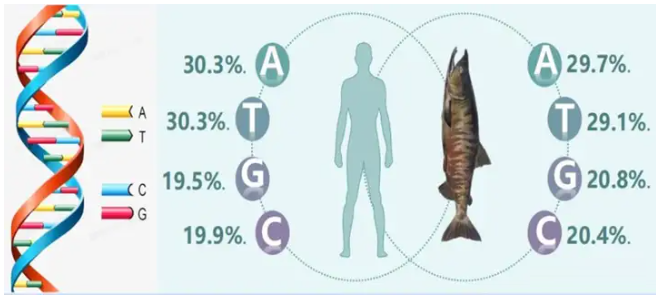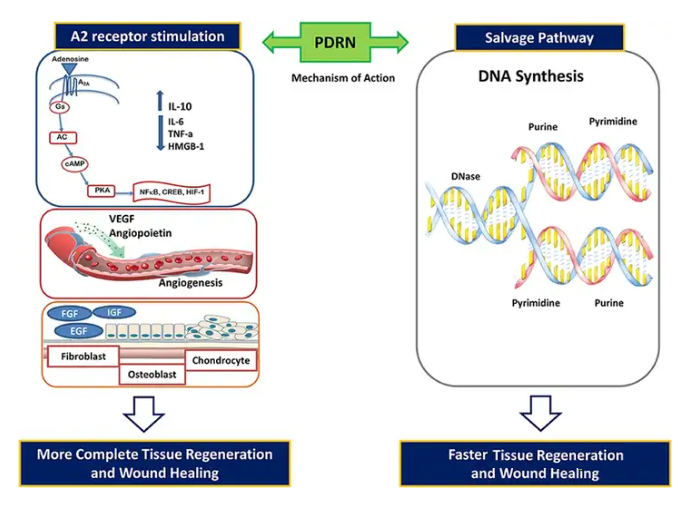1. Was ist PDRN?
PDRN (Polydesoxyribonukleotid) ist ein DNA-Fragment extrahiert und gereinigt aus Lachsspermien Seine Struktur ist sehr ähnlich der menschlichen DNA (bis zu 98 % Homologie) und bietet eine ausgezeichnete Biokompatibilität, ohne Immunabstoßungen oder Fremdkörperreaktionen auszulösen. Infolgedessen hat es in den Bereichen der medizinischen Ästhetik und der regenerativen Medizin große Aufmerksamkeit erlangt.

2. Wirkungsmechanismus: Der Adenosinrezeptor-Signalweg und die Zellreparatur
Der Kernmechanismus von PDRN ist eng mit dem Adenosin-Adenosin-Rezeptor-Signalweg verknüpft. Adenosin ist ein endogenes Nukleosid, das bei Gewebeschäden oder Hypoxie in großen Mengen freigesetzt wird und eine Schlüsselrolle bei der Regulierung des Energiehaushalts und der Initiierung von Reparaturvorgängen spielt.
Es gibt vier Arten von Adenosinrezeptoren (A1, A2A, A2B, A3) beim Menschen, von denen der A2A-Rezeptor in der Haut am häufigsten vorkommt. PDRN wird von Zellen aufgenommen und zu Adenosin abgebaut, das spezifisch die A2A-Rezeptoren auf der Zellmembran aktiviert. Diese Rezeptoren gehören zur Familie der G-Protein-gekoppelten Rezeptoren (GPCR), und ihre Aktivierung löst intrazelluläre Signalkaskaden aus, die mehrere reparaturbezogene physiologische Prozesse regulieren.

3. Wichtige biologische Wirkungen von PDRN
Nach der Aktivierung des A2A-Rezeptors übt PDRN seine reparativen Funktionen durch die folgenden Mechanismen aus:
(1) Förderung der Zellproliferation und -reparatur
Verbessert die Proliferation von Fibroblasten, Chondrozyten, Osteoblasten und anderen Zellen erheblich und beschleunigt die Regeneration von Weichteilen und Hautstrukturen.
(2) Starke entzündungshemmende Wirkung
Reduziert die Infiltration entzündlicher Zellen durch Hemmung entzündungsfördernder Zytokine (z. B. IL-6, TNF-α) und Erhöhung entzündungshemmender Faktoren (z. B. IL-10) und verbessert dadurch das Mikroumfeld der Wundheilung.
(3) Stimulation der Angiogenese und Verbesserung der Mikrozirkulation
Reguliert die Expression des vaskulären endothelialen Wachstumsfaktors (VEGF) hoch, fördert die Bildung neuer Blutgefäße und verbessert die Blutdurchblutung und Sauerstoffversorgung, um die Geweberegeneration zu unterstützen.
(4) Beschleunigung der Wundheilung und Geweberegeneration
Verbessert umfassend den Trauma-Reparaturprozess, verkürzt die Genesungszeit und verbessert die Heilungsqualität, sodass es für verschiedene Arten von Hautschäden und die Genesung nach Eingriffen geeignet ist.
4. Sicherheitsprofil und Forschungsunterstützung
Die Wirksamkeit und Sicherheit von PDRN werden durch umfangreiche Forschung unterstützt:
(1) Bis heute haben über 600 In-vitro-, In-vivo- und klinische Studien seine Wirksamkeit und Sicherheit bestätigt;
(2) Selbst bei Konzentrationen von bis zu 3 % (wie in der Ausgabe 2021 des Katalogs für kosmetische Inhaltsstoffe angegeben) weist es eine ausgezeichnete Verträglichkeit auf;
(3) Es wird häufig in der medizinischen Ästhetik eingesetzt, einschließlich Hautregeneration, Reparaturprodukten, Hydro-Gesichtstherapie und Erholung nach Eingriffen, mit signifikanten Ergebnissen und minimalen Risiken.
Zusammenfassend lässt sich sagen, dass PDRN einen dualen Mechanismus aus „biologischer Signalaktivierung + Rohstoffversorgung“ nutzt, indem es den körpereigenen, Adenosin-vermittelten Reparaturweg nachahmt und verstärkt. Es wirkt effizient und sicher entzündungshemmend, regenerativer und wundheilender. Damit ist PDRN nicht nur ein innovativer Bestandteil der medizinischen Ästhetik, sondern auch ein bewährtes wissenschaftliches Instrument in der regenerativen Medizin.